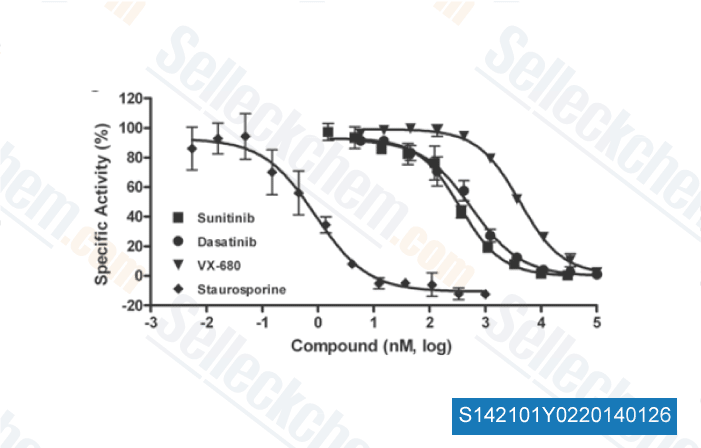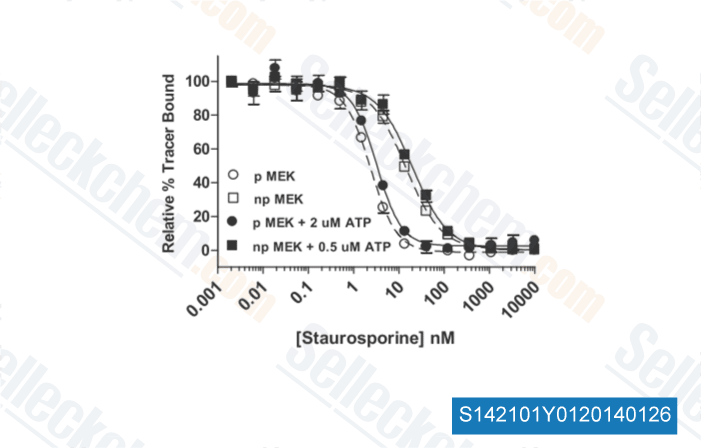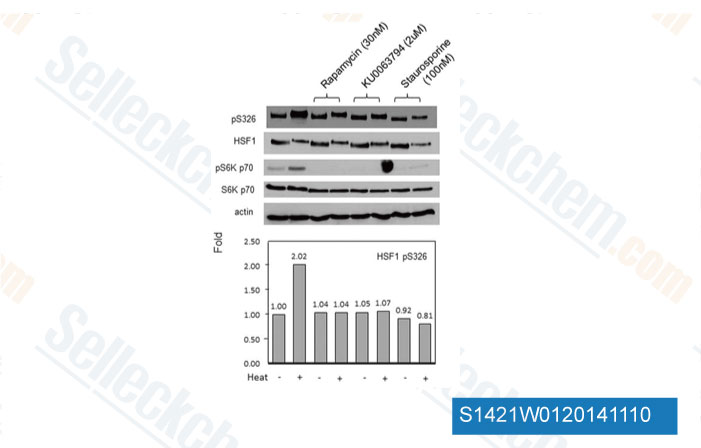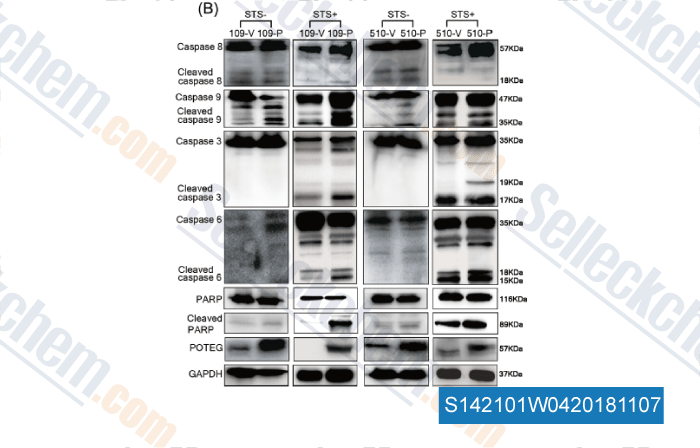|
Toll Free: (877) 796-6397 -- USA and Canada only -- |
Fax: +1-832-582-8590 Orders: +1-832-582-8158 |
Tech Support: +1-832-582-8158 Ext:3 Please provide your Order Number in the email. |
Technical Data
| Formula | C28H26N4O3 |
||||||
| Molecular Weight | 466.53 | CAS No. | 62996-74-1 | ||||
| Solubility (25°C)* | In vitro | DMSO | 93 mg/mL (199.34 mM) | ||||
| Water | Insoluble | ||||||
| Ethanol | Insoluble | ||||||
| In vivo (Add solvents to the product individually and in order) |
|
||||||
|
* <1 mg/ml means slightly soluble or insoluble. * Please note that Selleck tests the solubility of all compounds in-house, and the actual solubility may differ slightly from published values. This is normal and is due to slight batch-to-batch variations. * Room temperature shipping (Stability testing shows this product can be shipped without any cooling measures.) |
|||||||
Preparing Stock Solutions
Biological Activity
| Description | Staurosporine (STS) is a potent PKC inhibitor for PKCα, PKCγ and PKCη with IC50 of 2 nM, 5 nM and 4 nM, less potent to PKCδ (20 nM), PKCε (73 nM) and little active to PKCζ (1086 nM) in cell-free assays. Also shows inhibitory activities on other kinases, such as PKA, PKG, S6K, CaMKII, etc. Phase 3. | |||||||||||
|---|---|---|---|---|---|---|---|---|---|---|---|---|
| Targets |
|
|||||||||||
| In vitro | Staurosporine, a microbial alkaloid, significantly inhibits protein kinase C from rat brain with IC50 of 2.7 nM. Staurosporine displays strong inhibitory effect against HeLa S3 cells with IC50 of 4 nM. [1] Staurosporine also inhibits a variety of other protein kinases, including PKA, PKG, phosphorylase kinase, S6 kinase, Myosin light chain kinase (MLCK), CAM PKII, cdc2, v-Src, Lyn, c-Fgr, and Syk with IC50 of 15 nM, 18 nM, 3 nM, 5 nM, 21 nM, 20 nM, 9 nM, 6 nM, 20 nM, 2 nM, and 16 nM, respectively. [2] Staurosporine (1 μM) induces >90% apoptosis in PC12 cells. Consistently, Staurosporine treatment induces a rapid and prolonged elevation of intracellular free calcium levels [Ca2+]i, accumulation of mitochondrial reactive oxygen species (ROS), and subsequent mitochondrial dysfunction. [3] The apoptosis of MCF7 cells induced by Staurosporine can be enhanced by the expression of functional caspase-3 via caspase-8 activation and Bid cleavage. [4] Staurosporine treatment at 1 μM only partially inhibits IL-3-stimulated Bcl2 phosphorylation but completely blocks PKC-mediated Bcl2 phosphorylation. [5] Staurosporine induces apoptosis of human foreskin fibroblasts AG-1518, depending on the lysosomal cathepsins D mediated cytochrome c release and caspase activation. [6] In addition to activating the classical mitochondrial apoptosis pathway, Staurosporine triggers a novel intrinsic apoptosis pathway, relying on the activation of caspase-9 in the absence of Apaf-1. [7] | |||||||||||
| In vivo | In the gerbil and rat ischemia models, Staurosporine pretreatment (0.1-10 ng) before ischemia prevents neuronal damage in a dose-dependent manner, suggesting the involvement of PKC in CAl pyramidal cell death after ischemia. [8] |
Protocol (from reference)
| Kinase Assay: |
|
|---|---|
| Cell Assay: |
|
| Animal Study: |
|
References
|
Customer Product Validation

-
Data from [ J Biomol Screen , 2013 , 18(4), 388-99 ]

-
Data from [ J Biomol Screen , 2013 , 18(4), 388-99 ]

-
Data from [ PLoS One , 2012 , 7(6), e39679 ]

-
Data from [ , , Mol Carcinog, 2018, 57(7):886-895 ]
Selleck's Staurosporine (STS) Has Been Cited by 194 Publications
| Cytosolic cytochrome c represses ferroptosis [ Cell Metab, 2025, S1550-4131(25)00149-4] | PubMed: 40233758 |
| A Leishmania virulence factor harnesses an allosteric kinase switch to regulate its ubiquitin ligase activity [ Mol Cell, 2025, 85(19):3711-3728.e11] | PubMed: 40997810 |
| Targeting SUMO2 reverses aberrant epigenetic rewiring driven by SS18::SSX fusion oncoproteins and impairs sarcomagenesis [ EMBO J, 2025, 10.1038/s44318-025-00526-w] | PubMed: 40804185 |
| Deep transfer learning approach for automated cell death classification reveals novel ferroptosis-inducing agents in subsets of B-ALL [ Cell Death Dis, 2025, 16(1):396] | PubMed: 40382332 |
| EGFR-mediated crosstalk between vascular endothelial cells and hepatocytes promotes Piezo1-dependent liver regeneration [ Genes Dis, 2025, 12(3):101321] | PubMed: 40083329 |
| Capturing the Heterogeneity of the PDAC Tumor Microenvironment: Novel Triple Co-Culture Spheroids for Drug Screening and Angiogenic Evaluation [ Cells, 2025, 14(6)450] | PubMed: 40136699 |
| Impact of the changes in substrate specificity of herpes simplex virus 1 protein kinase Us3 on viral infection in vitro and in vivo [ J Virol, 2025, 99(7):e0040025] | PubMed: 40586577 |
| Ciprofloxacin enhances RSL3-induced ferroptosis by promoting mitochondrial Zn2+ accumulation via the STING1-CAV2 pathway [ J Biol Chem, 2025, 301(10):110653] | PubMed: 40889676 |
| Increased oxidative stress and autophagy in NGLY1 patient iPSC-derived neural stem cells [ Exp Cell Res, 2025, 448(1):114540] | PubMed: 40189184 |
| PTPN22-CD45 dual phosphatase retrograde feedback enhances TCR signaling and autoimmunity [ Sci Adv, 2025, 11(36):eadw2568] | PubMed: 40911684 |
RETURN POLICY
Selleck Chemical’s Unconditional Return Policy ensures a smooth online shopping experience for our customers. If you are in any way unsatisfied with your purchase, you may return any item(s) within 7 days of receiving it. In the event of product quality issues, either protocol related or product related problems, you may return any item(s) within 365 days from the original purchase date. Please follow the instructions below when returning products.
SHIPPING AND STORAGE
Selleck products are transported at room temperature. If you receive the product at room temperature, please rest assured, the Selleck Quality Inspection Department has conducted experiments to verify that the normal temperature placement of one month will not affect the biological activity of powder products. After collecting, please store the product according to the requirements described in the datasheet. Most Selleck products are stable under the recommended conditions.
NOT FOR HUMAN, VETERINARY DIAGNOSTIC OR THERAPEUTIC USE.
